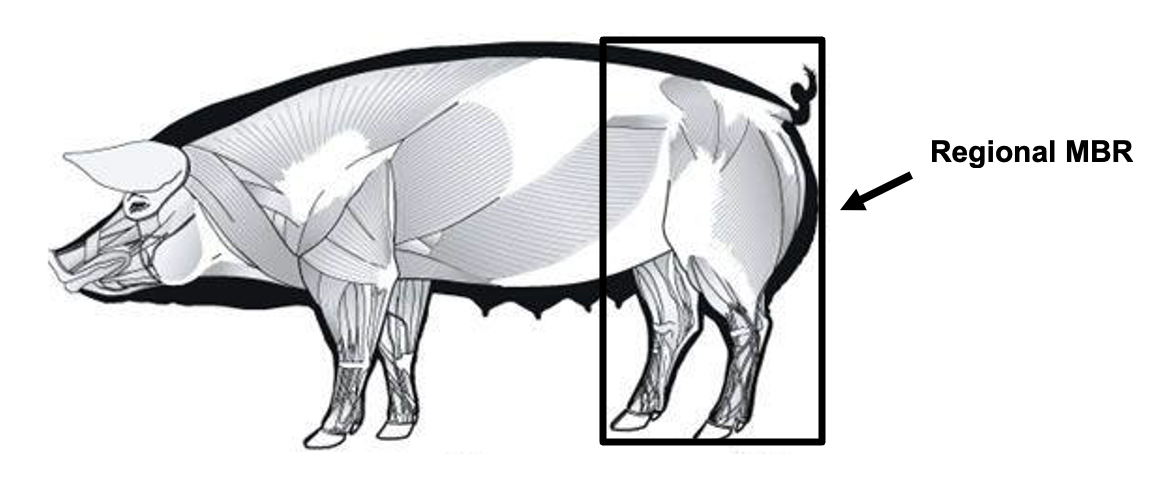The muscle-to-bone ratio (MBR) has become a topic of interest in the world of athletics and performance. Although some sports performance professionals and athletes may feel that the MBR is a new way to evaluate the body, the concept has actually been around for quite some time.
For almost 40 years, the animal science/meat industry has been using MBR as an objective way to evaluate and characterize meat (Young & Sykes, 1987; Dumont & Pouliquen, 1988). Obviously, this is a little different idea of how to use MBR, than most athletes and sport professionals are thinking of using it but the concept is similar. In the animal science industry, the MBR can be calculated two different ways. One way to calculate the total MBR is to take the weight of an animal’s total muscle mass and divide it by the weight of the animal’s total bone mass. This can be termed the total MBR. The second way to calculate the MBR is to calculate a regional MBR. This is typically done by dividing the amount of hind leg muscle mass by the weight of the hind leg bone mass. In this case, the femur bone and surrounding muscle are often used (Hopkins, 1996). Whether looking at the total or regional MBR, the general concept is that as the MBR increases, muscularity and meat yield increase (Hopkins, 1996). Of course, there are exceptions that can affect this. A higher MBR can also be the result of lighter bones rather than heavier muscles. Similarly, a lower MBR can also be due to heavier bones even though the amount of muscle stays the same (Purchas et al., 1991).

The world of sports has taken this idea of MBR and tried to apply it to body composition. It has been suggested that MBR describes the physiological adaptations from mechanical loading of muscle on the bone (Lee et al., 2015). A number of researchers have investigated the use of MBR in different sports such as rugby, volleyball, tennis, soccer, and swimming (Bernal-Orozco et al., 2020; Brocherie et al., 2014; Carvajal et al., 2012; Gomez-Bruton et al., 2019; Holway & Garavaglia, 2009; Ireland et al., 2013). In a majority of these studies, MBR was determined by using anthropometry (i.e., skinfolds, circumferences, girths, etc.) (Bernal-Orozco et al., 2020; Brocherie et al., 2014; Carvajal et al., 2012; Holway & Garavaglia, 2009). The anthropometric measurement techniques and equations to determine muscle mass and bone mass have many limitations that may be affecting the accuracy. Given the accuracy of dual X-ray absorptiometry (DXA) to determine muscle, fat, and bone masses DXA may be a more reliable option to evaluate MBR.
To date, only one study has assessed DXA-derived MBR in athletes. This study was in adolescent swimmers (Gomez-Bruton et al., 2019). Recently, my laboratory has started a series of studies in athletes to examine the MBR using DXA. In the next few blogs, we will explore some of the research that we have published on regional as well as total MBR.
REFERENCES
Bernal-Orozco, M. F., Posada-Falomir, M., Quiñónez-Gastélum, C. M., Plascencia-Aguilera, L. P., Arana-Nuño, J. R., Badillo-Camacho, N., Márquez-Sandoval, F., Holway, F. E., & Vizmanos-Lamotte, B. (2020). Anthropometric and Body Composition Profile of Young Professional Soccer Players. Journal of Strength and Conditioning Research, 34(7), 1911–1923.
Brocherie, F., Girard, O., Forchino, F., Al Haddad, H., Dos Santos, G. A., & Millet, G. P. (2014). Relationships between anthropometric measures and athletic performance, with special reference to repeated-sprint ability, in the Qatar national soccer team. Journal of Sports Sciences, 32(13), 1243–1254.
Carvajal, W., Betancourt, H., León, S., Deturnel, Y., Martínez, M., Echevarría, I., Castillo, M. E., & Serviat, N. (2012). Kinanthropometric Profile of Cuban Women Olympic Volleyball Champions. MEDICC Review, 14(2), 7.
Dumont, B. L. & Pouliquen, O. (1988). Morphological traits of femur and tibia in relation to fleshiness (muscle bone ratio) in lambs. In 3. Congres Mondial de Reproduction et Selection des Ovins et Bovins a Viande, Paris (France), 19-23 Jun 1988. INRA.
Gomez-Bruton, A., Gonzalez-Aguero, A., Matute-Llorente, A., Lozano-Berges, G., Gomez-Cabello, A., Moreno, L. A., Casajus, J. A., & Vicente-Rodríguez, G. (2019). The muscle-bone unit in adolescent swimmers. Osteoporosis International, 30(5), 1079–1088.
Holway, F. E., & Garavaglia, R. (2009). Kinanthropometry of Group I rugby players in Buenos Aires, Argentina. Journal of Sports Sciences, 27(11), 1211–1220.
Hopkins, D. L. (1996). The relationship between muscularity, muscle:bone ratio and cut dimensions in male and female lamb carcasses and the measurement of muscularity using image analysis. Meat Science, 44(4), 307–317.
Ireland, A., Maden-Wilkinson, T., Mcphee, J., Cooke, K., Narici, M., Degens, H., & Rittweger, J. (2013). Upper Limb Muscle–Bone Asymmetries and Bone Adaptation in Elite Youth Tennis Players. Medicine & Science in Sports & Exercise, 45(9), 1749–1758.
Lee, D. Y., Wetzsteon, R. J., Zemel, B. S., Shults, J., Organ, J. M., Foster, B. J., Herskovitz, R. M., Foerster, D. L., & Leonard, M. B. (2015). Muscle Torque Relative to Cross-Sectional Area and the Functional Muscle-Bone Unit in Children and Adolescents With Chronic Disease. Journal of Bone and Mineral Research, 30(3), 575–583.
Purchas, R.W., Davies, A.S., & Abdullah, A.Y. (1991). An objective measure of muscularity: Changes with animal growth and differences between genetic lines of Southdown sheep. Meat Science 30, 81-94.
Purchas, R. W., Fisher, A. V., Price, M. A., & Berg, R. T. (2002). Relationships between beef carcass shape and muscle to bone ratio. Meat Science, 61(3), 329–337.
Young, M.J. & Sykes, A.R. (1987). Bone growth and muscularity. Proceedings of the New Zealand Society of Animal Production 47: 73–75.
About the Author
Donald Dengel, Ph.D., is a Professor in the School of Kinesiology at the University of Minnesota and is a co-founder of Dexalytics. He serves as the Director of the Laboratory of Integrative Human Physiology, which provides clinical vascular, metabolic, exercise and body composition testing for researchers across the University of Minnesota.